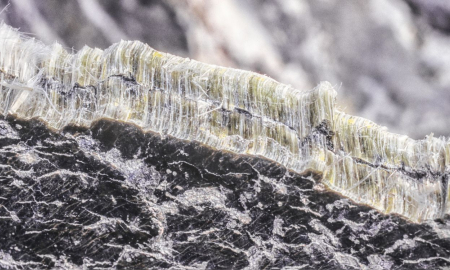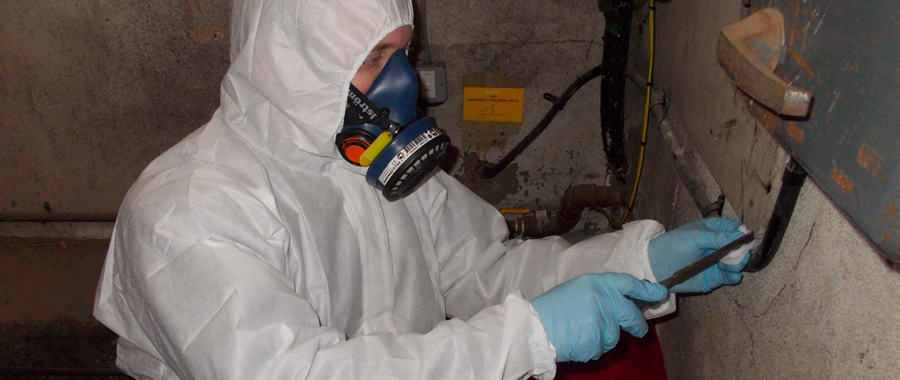Mapping Asbestos in Concrete:
Laying the Foundations for
Safe Building Demolition
Until the late 1970s, asbestos was a commonly used building material and, despite its use declining until a total ban was implemented in 1999, its legacy lives on in over 5.5 million buildings in the UK.
This can bring a number of challenges when it comes to building demolition, due to the health and safety hazards involved in managing asbestos and asbestos containing materials (ACMs). It is crucial to establish the extent of such substances prior to carrying out any refurbishment or demolition work on a building.
A key challenge when investigating the presence of ACMs is that the sampling techniques currently used do not fully explore where such substances may be hidden, even when substantial numbers of samples are taken across a site. This is particularly true when it comes to identifying ACMs in concrete, mortar and floor screed.
In these cases - such as a project recently carried out on a public building by SOCOTEC as a UKAS accredited inspection body (schedules 0148 and 1089) - it’s essential that additional destructive investigation is carried out. In some instances, it may be necessary to employ the services of a Licensed Asbestos Removal Contractor (LARC) to facilitate full access for inspection bodies like SOCOTEC to the area that needs to be surveyed. This is vital to determine the precise location and extent of ACMs across the building, and ensure safe and efficient demolition.
Sampling in practice
As part of the building’s initial construction in the early 1970s, an asbestos sprayed coating had been applied to the beams, and asbestos insulating board fitted to the ceilings. Over the last 40 years, the asbestos had been largely removed, but a survey highlighted that it was still present within the mortar and floor screed.
To determine the extent and precise location of the remaining asbestos contamination, significant additional sampling was required. The sample methods were destructive and necessitated utilising a LARC to carry out the work under fully enclosed conditions, with a surveyor in attendance, backed up with personal and static air monitoring.
Asbestos in mortar
Initially, several hundred samples were taken by drilling into the mortar layers, however a full picture of where ACMs were located could not be determined. A LARC was then employed to undertake a trial area of wall removal under fully controlled conditions. Once the bricks were lifted, the contamination was readily observed in the form of clumps of free fibre, and the positive samples were recorded on a site plan.
Asbestos in floor screed
ACM contamination of floor screed is a well-known issue to surveyors. Screed is commonly laid over asbestos-contaminated concrete surfaces from the original building site that may not have been cleared up effectively beforehand. On this particular project, the contamination of the floor screed was considered a real possibility.
To determine whether this was the case, traditional screed sampling was initially carried out throughout the interior. This involved taking samples from the floor, following a grid pattern at regular intervals. However, while this process located ACMs, it couldn’t determine the extent of its presence, making it crucial to call in a LARC to lift larger areas of screed.
Under the direction of SOCOTEC’s UKAS accredited team, the LARC lifted square-metre sections of screed under fully controlled conditions. Analysis of these sections identified the presence of extensive sprayed coating and asbestos insulating board (AIB) contamination in all areas, even those previously thought to be clear - significantly in areas of the building where the beams had never been sprayed. The results suggested that the material had been walked around the site on workmen’s boots and carried on equipment during initial construction.
Mapping asbestos in this way, and understanding the source of the contamination, helped to ensure the demolition could subsequently be carried out safely.
Asbestos in concrete
Initial analysis of the concrete on the site, using concrete coring carried out at over 100 points, surprisingly showed that approximately five per cent of the samples contained amosite. Subsequently, a single 170 square metre area and nine smaller areas were excavated under fully controlled conditions, which revealed the presence of asbestos sprayed coating in over 95 per cent of the samples.
Ensuring accuracy and safety
As the method for removing different materials from a building can vary, preventing cross-contamination during the investigation was essential to ensure the sample results were accurate and the correct removal method selected. With this in mind, particular care was given to prevent cross-contamination of samples within live enclosures.
As within any investigation, leaving a safe environment is essential. In this case, walls where courses of bricks had been removed as part of the investigation were lowered to a level where there was no danger of them falling and screed inspection points were cleaned, encapsulated, and waste material removed. The trial pits were also filled and boarded or barriered. Clearance tests were carried out and the areas cleaned and made safe.
Demolition will, by its nature, reveal a building’s hidden surprises. When it comes to asbestos, a full and precise picture of the location and presence of contamination is required. As our recent investigation demonstrates, working with a LARC can be a necessity when investigating areas that require extensive intrusive access, to uphold the highest standards of health and safety when there is a high risk asbestos products may be encountered.
To find out more about the obligations of building owners under the Asbestos Regulations, and about our UKAS accredited asbestos management support, please click here.






Add new comment